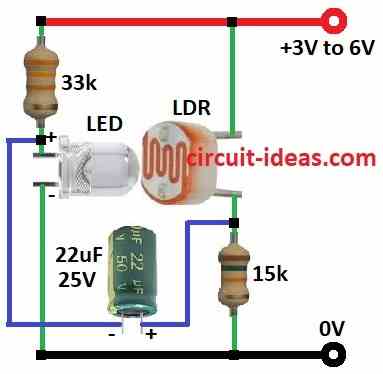An LED and an LDR is used to make this simple basic flasher circuit.
This circuit controls the LEDs blinking pattern by taking use of the LDRs ability to change resistance in response to light intensity.
Without the need of complicated chips or transistors this device produces the effect of blinking LEDs.
Basic electrical parts including resistors, capacitors and a unique type of light sensitive resistor known as an LDR are used in it.
Circuit Working:

Parts List:
| Category | Description | Quantity | Wattage |
|---|---|---|---|
| Resistors | 33k | 1 | 1/4W |
| 15k | 1 | 1/4W | |
| Sensors | LDR (Light Dependent Resistor) | 1 | |
| Capacitors | Electrolytic 22μF 25V | 1 | |
| Semiconductors | White LED 5mm 20mA | 1 |
In this circuit consider the LED and LDR working together as a team, the LED illuminates the LDR with some light.
By acting as a signal, this light lowers the resistance of the LDR to electrical current passing through it.
An LED may conduct more current and become brighter when there is less resistance.
As a result, a feedback loop is created a brighter LED provides a stronger signal to the LDR which enables the LED to get even brighter it does not last forever though.
The circuit has a capacitor that functions as a temporary energy storage device.
The capacitor gradually filled with power while the LED shines.
When the capacitor is full the LED is unable to receive energy and turns off.
When the LED is off, the LDR is exposed to less light and regains its resistance.
The capacitor begins to release its stored energy gradually restoring some current to the LED.
This small amount of current is sufficient to restart the cycle slightly brightening the LED and decreasing the resistance of the LDR resulting in a full fledged blink.
Similar to a see-saw, the LED and LDR function.
The LDR loses resistance when the LED becomes brighter (one side goes down, the other side goes up).
The teeter totter finally returns to level when the capacitor, which functions as a timer, stops the LED from being too bright.
The LED can then begin to brighten once again resuming the teeter totter activity as the capacitor releases its stored power.
Additional tips for a stronger signal:
- Install a bright LED in close proximity to the LDR.
- The circuit is functional in dimly lit areas, but intense light causes the LDR to become too conductive which stops the blinking.
- The circuit may be powered by an adapter or tiny battery.
- This is a basic yet fascinating circuit that shows how simple parts may combine to produce an eye catching flashing effect.
Formulas:
With a simple arrangement of a resistor and capacitor, an LED and LDR flasher circuit may be created.
Here is the general formula:
The RC time constant of the resistor capacitor network may be used to estimate the LEDs flashing frequency f:
f = 1 / 2.2 * R * C
where,
- R is the resistance in ohms Ω.
- C is the capacitance in farads F.
Using the RC time constant as a foundation, this calculation provides an estimated frequency. Modifications to R and C will alter the LEDs rate of flashing.
How to Build:
To build a simple Flasher Circuit using LED and LDR follow the below mentioned steps for connections:
- Gather all the components as mentioned in the diagram above:
- Connect the anode of LED to positive supply through resistor 33k.
- Connect the cathode of LED to ground.
- Connect LDR one leg to positive supply and other leg to ground through resistor 15k.
- Connect a anode of 22μF capacitor between LDR and 15k resistor and cathode of capacitor 22μF between anode of LED and resistor 33k
Conclusion:
To conclude, this LED flasher circuit provides an intriguing illustration of how basic electrical parts may provide a dynamic effect.
Through astute use of the interaction between an LED, an LDR and passive parts like resistors and capacitors we are able to create a circuit that oscillates on its own and produces a flickering light.
This project acts as a springboard for investigating more intricate electrical works of art in addition to showcasing a useful application of light sensing technology.
Leave a Reply